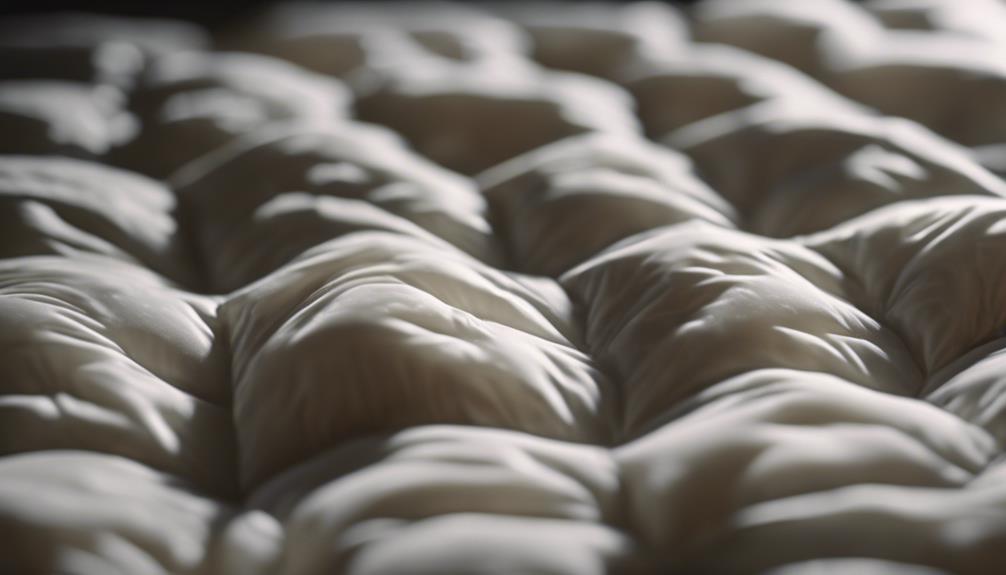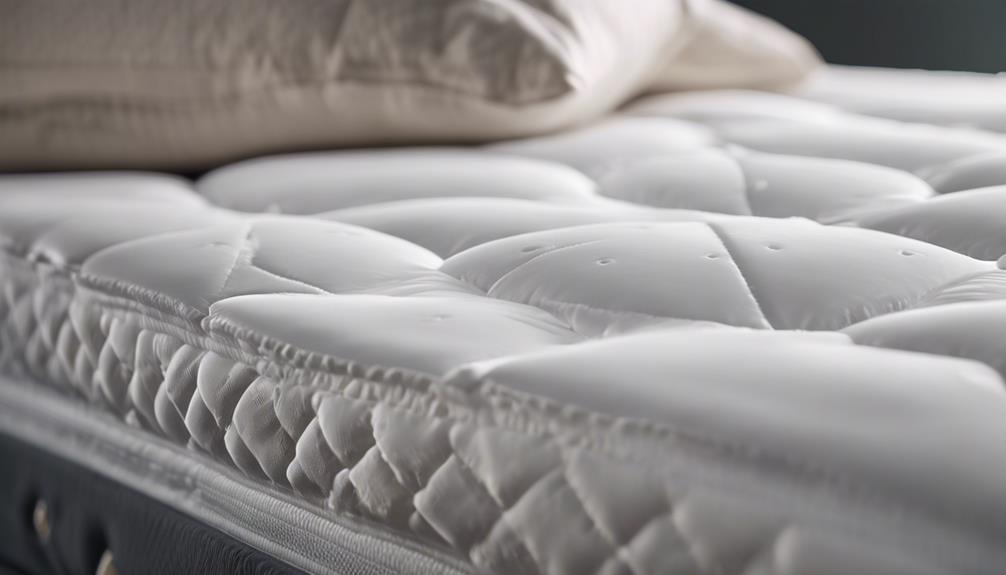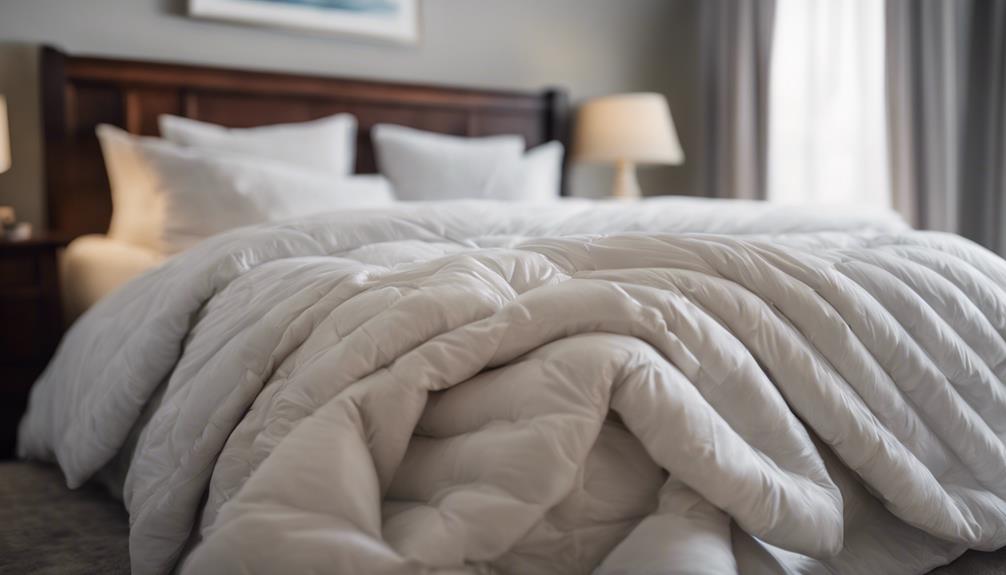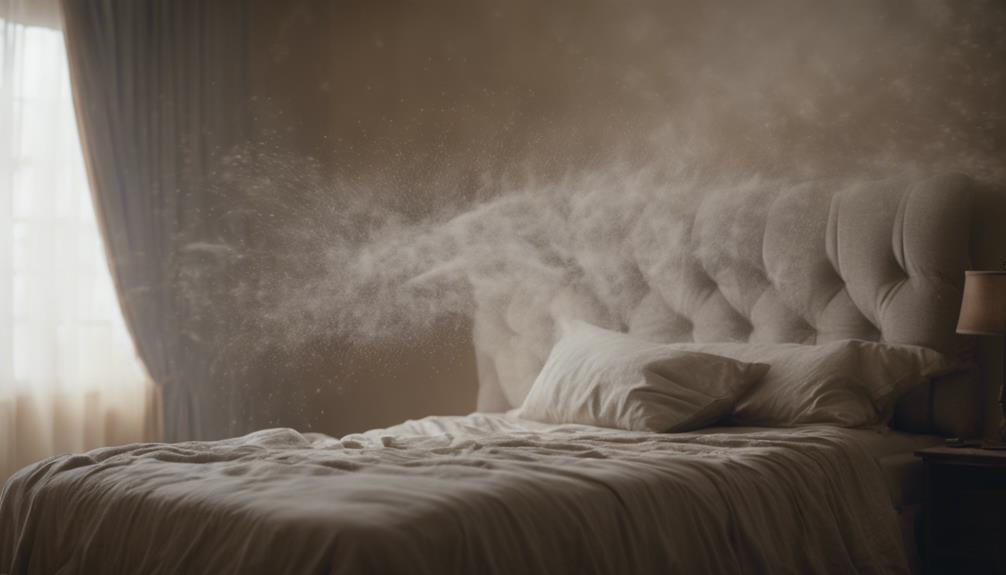If your goose down comforter has an unusual odor, it may be attributed to chemicals used in the disinfecting process, natural scents from feathers, or environmental conditions during storage. The quality of the down material and manufacturing processes can also play a role, along with regulations on chemical usage and manufacturing standards. Quality control measures are in place to reduce odors and provide a fresh product. Airing out the comforter, using baking soda or vinegar, professional cleaning, proper storage, and ventilation are all recommended remedies. Understanding these factors can assist in keeping your comforter smelling pleasant.
Key Takeaways
- Chemicals in disinfecting process and natural odors from feathers can cause smells.
- Environmental factors during storage, like humidity, can lead to unpleasant odors.
- Quality of down material and manufacturing processes impact the odor development.
- Regulations on chemical usage and geographic manufacturing standards affect smell levels.
- Effective remedies include sun exposure, baking soda, professional cleaning, and alternative products.
Chemicals in Disinfecting Process
During the manufacturing process, we apply disinfectant chemicals to goose down comforters, which can contribute to the noticeable odor some may experience. These chemicals are necessary to make sure that the comforters are free from harmful bacteria and microbes.
However, the disinfectant chemicals used in this process can release odors over time, especially if not properly aired out before use. Residual disinfectant on the down feathers may emit a noticeable scent that lingers even after initial unpacking.
The quality control measures during the disinfecting process play an important role in determining the intensity of the odor in goose down comforters. Proper ventilation and airing out of the comforter can help dissipate the smell from these disinfectant chemicals.
Understanding the role of these chemicals in the manufacturing process can provide insight into why some goose down comforters may have a noticeable odor initially.
Natural Odors From Feathers

Natural odors from goose down comforters often stem from the oils and proteins within the feathers, giving off a musky or earthy scent.
These scents can become more pronounced when the comforter is compressed or exposed to moisture, so proper airing out is essential for dissipating them over time.
While these smells are inherent to down, regular maintenance and care can help minimize their intensity and keep your comforter fresh.
Feather Odor Causes
When exploring the reasons for the odor emanating from your goose down comforter, it's important to take into account the natural oils present in the feathers. These oils can contribute to a slight earthy or musky smell that is more noticeable in newly purchased or freshly cleaned comforters. The distinctive scent from feathers is a common characteristic of down bedding products. Proper airing and regular fluffing of the comforter can help dissipate these natural odors over time.
| Feather Odor Causes | Proper Care |
|---|---|
| Natural oils in feathers | Regular fluffing |
| Earthy or musky smell | Proper airing |
| Common in down bedding | – |
Remedies for Smell
What're effective remedies for addressing the natural odors emanating from goose down feathers in your comforter?
To combat the smell, consider regularly airing out your comforter and using baking soda or vinegar during washing to neutralize odors. These methods can help prevent and reduce the natural odors caused by the oils and proteins in the feathers.
Additionally, seeking professional dry cleaning services that specialize in cleaning down comforters can effectively eliminate lingering odors. Remember to also wash the comforter cover frequently to maintain freshness and prevent odors from permeating the feathers.
Environmental Factors During Storage
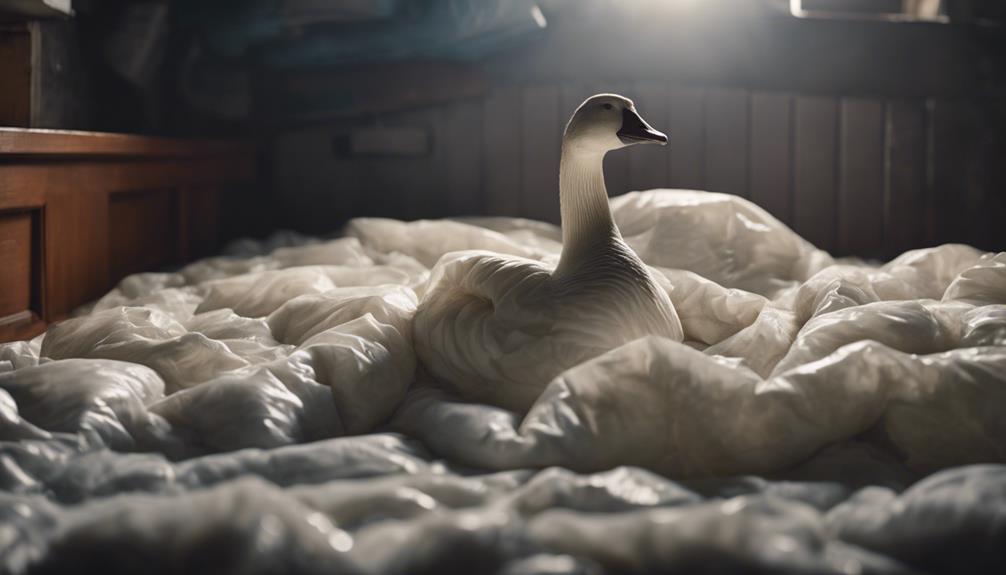
During storage, environmental factors such as humidity and lack of ventilation can contribute to odors developing in goose down comforters. Moisture in the air may become trapped within the comforter, leading to a musty or mildew smell over time.
Areas with insufficient sunlight exposure and airflow can also play a role in the development of unpleasant odors in these comforters. Storing them in tightly enclosed spaces can worsen odor problems as the lack of circulation prevents proper airing out.
To help prevent and reduce lingering odors, it's vital to properly ventilate storage areas and periodically air out the goose down comforters. By addressing these environmental factors, you can maintain the freshness of your comforter and ensure a pleasant sleeping experience.
Quality of Down Material
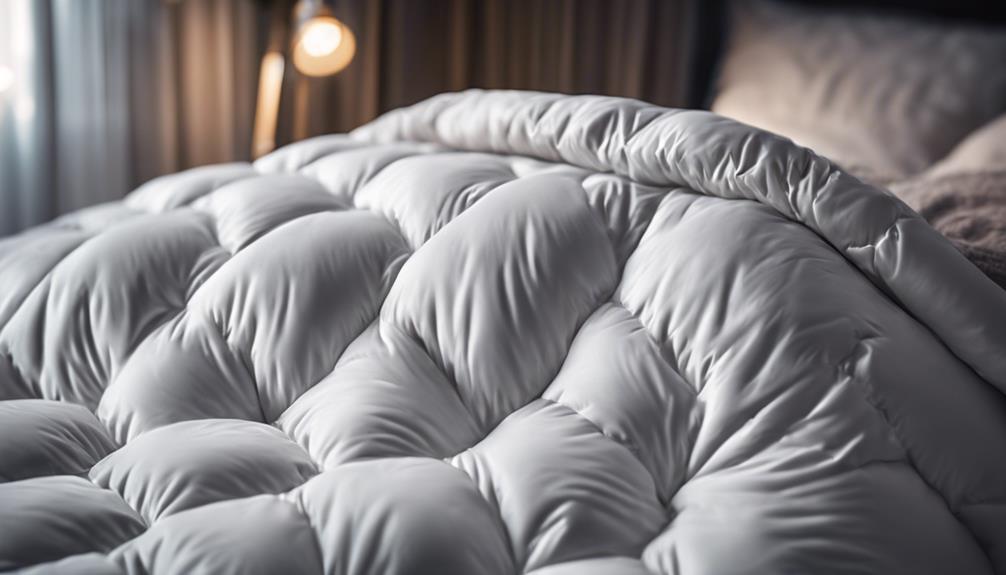
Exploring the quality of down material in goose down comforters reveals important insights into the prevention of lingering odors. The type of down material used can have a substantial impact on the potential for odors in your comforter. Higher quality down, such as Hungarian or European goose down, is less likely to retain odors compared to lower quality alternatives. Down sourced from mature geese tends to have fewer natural oils that can cause unpleasant smells, contributing to a fresher bedding experience.
Properly cleaned and processed down material undergoes treatments that help reduce odors, ensuring a more pleasant sleeping environment. On the other hand, inferior quality down or improper processing methods may lead to a stronger smell in comforters, making it essential to pay attention to the quality of down material when selecting a goose down comforter. By opting for high-quality down and ensuring proper processing, you can minimize the risk of odors and enjoy a fresh, comfortable bedding experience.
Manufacturing Processes Impact
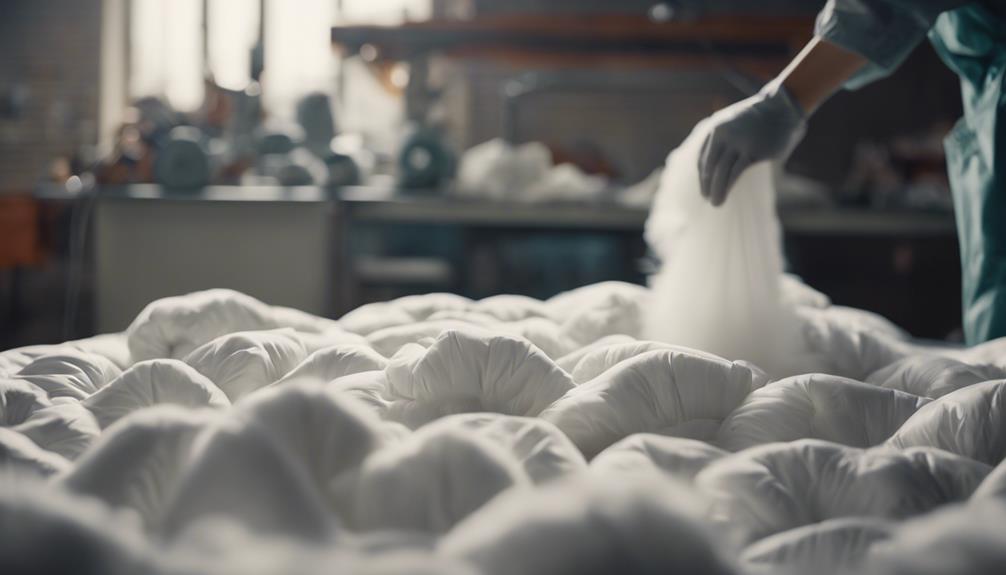
The manufacturing processes employed greatly influence the presence of odors in goose down comforters. When wet goose feathers are processed, various chemicals may be used for disinfection or preservation purposes. These chemicals can sometimes lead to lingering smells in the final product.
Vital control measures during manufacturing play a significant role in ensuring the freshness of the comforter, as any lapses in this process can result in odors developing over time. Additionally, environmental factors such as humidity levels and storage conditions during production can also impact the development of unwanted odors in goose down comforters.
As a result, it's essential for manufacturers to carefully monitor and regulate these aspects to minimize the presence of odors in the finished product. By understanding how manufacturing processes can influence the odor of goose down comforters, consumers can make more informed decisions when selecting their bedding.
Geographic Manufacturing Standards
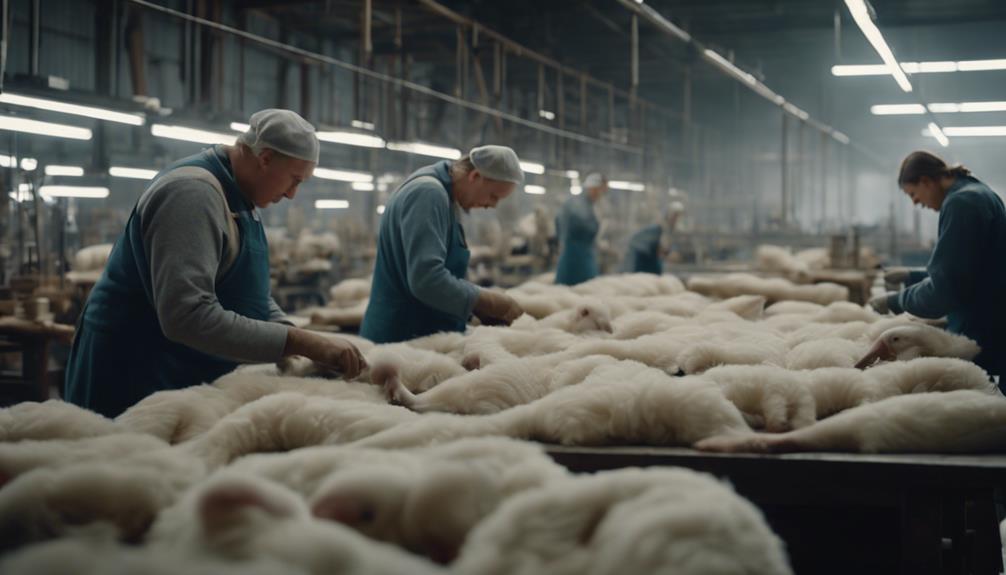
Geographic manufacturing standards greatly influence the quality and odor control measures of goose down comforters. Different countries impose varying regulations on chemical usage in production. For example, countries like China may have different standards for the use of chemicals, impacting potential odors in the comforters.
These standards also affect processes like high heat treatment and excess water removal, important for guaranteeing freshness and odor resistance in the comforters. The geographical origin of down materials can influence the natural odor and overall quality of the comforter, contributing to the presence or absence of unpleasant smells.
Additionally, shipping and storage conditions during transportation from manufacturing locations play a significant role in maintaining freshness and preventing unwanted odors in goose down comforters. By adhering to specific geographic manufacturing standards, manufacturers can ensure that their products meet quality expectations and provide customers with odor-free comforters.
Regulations on Chemical Usage

Regulations on chemical usage in down comforter production differ across countries and regions, with some having stringent guidelines to control the types and quantities of chemicals used. These regulations are in place to safeguard consumers and the environment during the manufacturing process.
Understanding these standards can help buyers make informed decisions when selecting down products.
Chemical Safety Standards
How do regional variations in chemical safety standards impact the quality of goose down comforters?
Manufacturers must comply with strict guidelines to limit harmful chemicals in comforters, ensuring safety for consumers. These regulations vary by region and country, influencing the overall quality of down comforters available in the market. By adhering to these standards, manufacturers guarantee that comforters meet health and environmental requirements.
Understanding these chemical safety standards is vital for consumers to make informed decisions when purchasing down comforters. When cleaning your comforter, consider air drying it instead of using a washing machine to prevent any potential chemical residue from affecting its quality.
Environmental Impact Considerations
Considering the environmental impact, manufacturers must adhere to specific guidelines on chemical usage in down comforter production. Regulations vary by region and country, dictating permissible levels of disinfectants and treatments. Different rules exist for the use of odor-reducing chemicals in comforters, depending on the geographical location. Quality control measures in production facilities play a significant role in the potential smell of down comforters.
The environmental impact of chemical usage is an important consideration for regulations governing down comforter production. Consumers may wonder about dry cleaning options to eliminate any awful smell from their comforters, but it's essential to follow care instructions to maintain the quality and longevity of the product while also considering the environmental implications of the cleaning methods chosen.
Quality Control Measures
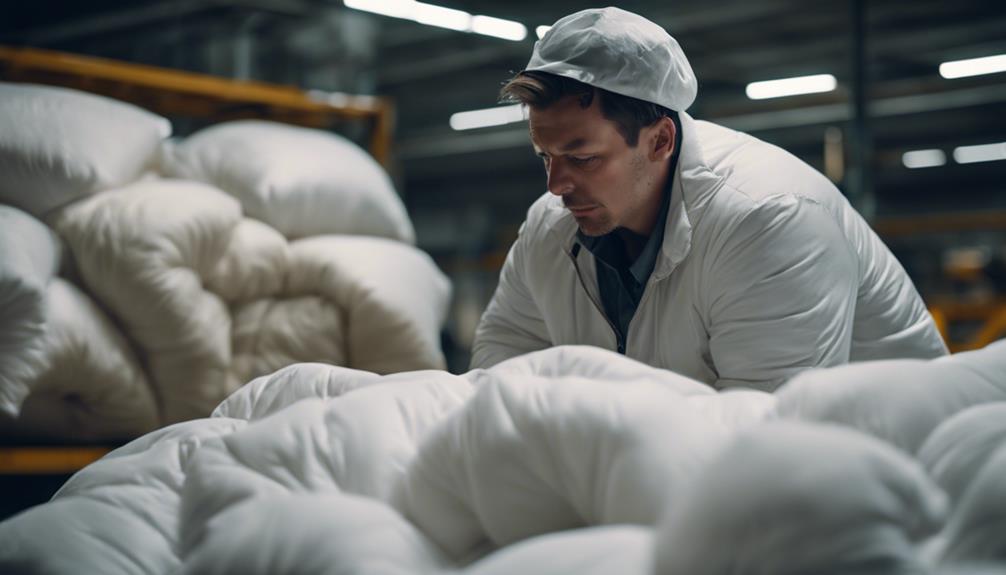
Implementing stringent quality control measures guarantees that only high-quality materials are used in the manufacturing of down comforters. Inspections throughout production help identify any issues with the down filling that could lead to odors. Manufacturers may implement strict standards and protocols to minimize the risk of odor development in comforters. Testing procedures involve evaluating the cleanliness and freshness of the down before it is used in comforter production. Quality control measures play a vital role in maintaining the reputation of brands known for odor-free down comforters.
| Quality Control Measures | Description | Importance |
|---|---|---|
| Inspections | Identify issues with down filling | Ensures quality and freshness |
| Standards and Protocols | Minimize risk of odor development | Maintains brand reputation |
| Testing Procedures | Evaluate cleanliness of down | Guarantees odor-free comforters |
Effective Remedies for Odors
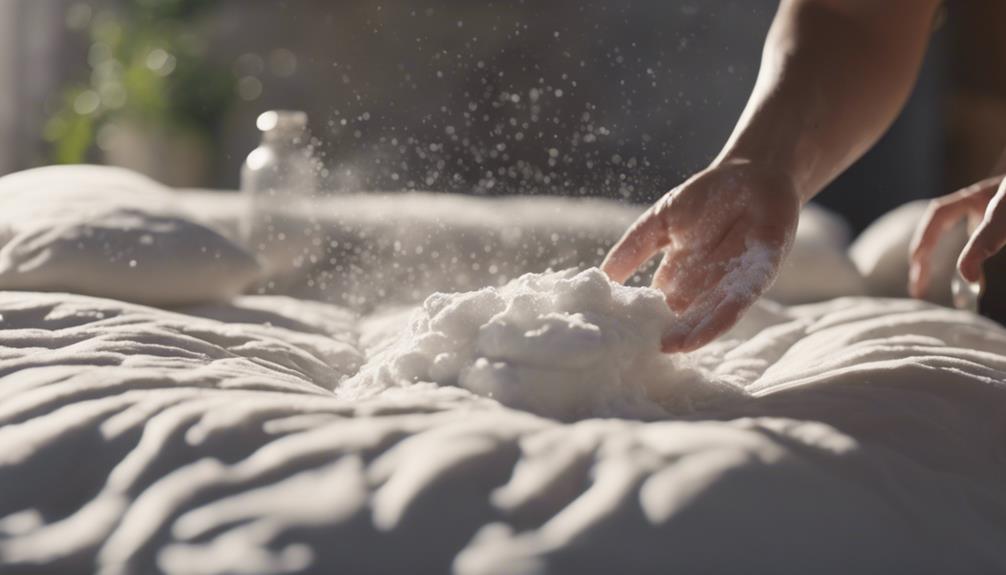
To combat any lingering odors in your goose down comforter, practical solutions can be employed to restore freshness and eliminate unpleasant smells. Proper airing out and sun exposure can help eliminate odors from the comforter.
If your comforter smells like wet dog, try using baking soda or vinegar during washing to assist in removing the unpleasant odors. Seeking professional dry cleaning services can effectively eliminate persistent smells.
Additionally, scented sachets or dryer sheets can be used to add a pleasant fragrance and mask any lingering odors in the comforter. For a long-term solution, consider exploring down alternative products or hypoallergenic options for odor-resistant bedding.
These remedies can help keep your goose down comforter fresh and free from unwanted smells, ensuring a comfortable and pleasant sleeping experience.
Impact of Storage and Shipping
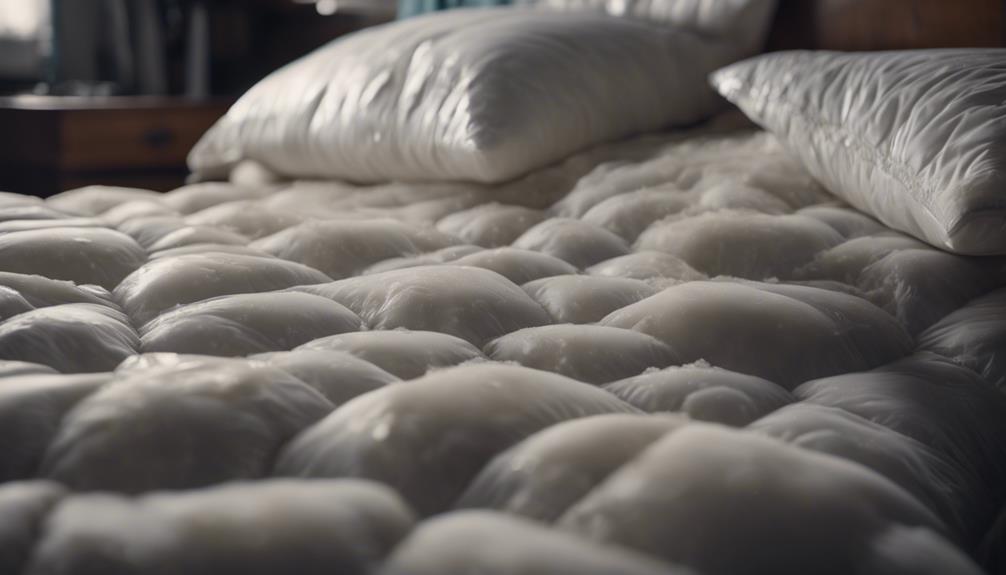
Storing and shipping goose down comforters improperly can contribute to the development of musty odors due to factors such as prolonged exposure to humidity and inadequate ventilation. When comforters are stored in non-breathable containers, they're at risk of trapping moisture, creating a damp environment that fosters unpleasant smells.
Similarly, during shipping, comforters may encounter varying environmental conditions that can impact their freshness. To prevent musty odors, it's essential to make sure that comforters are stored in dry, well-ventilated areas. Additionally, proper ventilation and avoiding sealing comforters in airtight spaces can help prevent odors from becoming trapped.
The quality of storage facilities and transportation methods also plays an important role in maintaining the freshness of goose down comforters. By taking these precautions, you can help your comforter stay away from musty smells and ensure it remains fresh and inviting.
Frequently Asked Questions
How Do You Get the Smell Out of a Down Comforter?
To get the smell out of a down comforter, we recommend washing it with warm water, vinegar, and mild detergent. Adding tennis shoes in the wash can prevent clumping and aid in odor removal.
Air drying the comforter outside can help eliminate odors and musty scents. Fragrance sprays may temporarily mask odors but washing and proper drying guarantee long-lasting freshness.
Why Does My Goose Down Comforter Smell After Washing?
After washing, our goose down comforter might smell due to residual moisture causing mildew growth. Inadequate drying can lead to musty odors as fungal spores thrive in damp conditions. To eliminate post-washing odors, guarantee thorough drying using low heat.
Storing washed comforters in breathable bags can prevent odor buildup and maintain freshness. Proper drying techniques are key to keeping our goose down comforter smelling fresh and clean.
How to Get Rid of Goose Down Smell?
To get rid of goose down smell, we suggest:
- Airing out and sun exposure
- Using baking soda or vinegar during washing
- Seeking professional cleaning services
Scented sachets or dryer sheets can temporarily mask odors. If the smell persists, consider replacing the down filling with alternative materials.
Airing out and proper cleaning methods can help maintain a fresh-smelling goose down comforter.
How to Stop Feather Duvet From Smelling?
To prevent your feather duvet from smelling, follow these steps:
- Make sure it's properly dried after washing.
- Add a fungicide when washing.
- Store it in breathable cotton bags.
Avoid trapping moisture by removing duvets from plastic bags. Seek advice from experts at Farthings Cambridge or Trumpington for further help.
Proper care can combat odors effectively and keep your duvet smelling fresh.
Is the Smell of My Goose Down Comforter Normal or is it a Sign of a Problem?
If you’re wondering what is goose down comforter‘s smell, it is normal for it to have a slight natural odor due to the feathers’ oils. However, if the smell is musty or mildew-like, it could indicate a problem such as moisture retention or improper cleaning.
Conclusion
To sum up, the smell of your goose down comforter can be attributed to various factors such as the chemicals used in the disinfecting process, natural odors from feathers, environmental factors during storage, and the quality of the down material.
Understanding these factors can help you effectively address any unwanted odors and guarantee the longevity of your comforter.
Remember, a little maintenance goes a long way in keeping your bedding fresh and comfortable.
